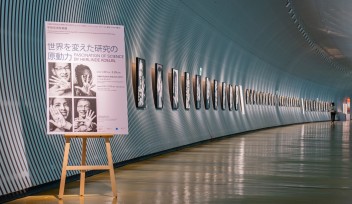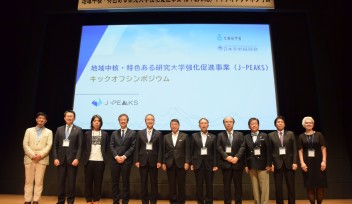New possibilities for science and art: From the perspective of science communication

On September 26, 2024, the Okinawa Institute of Science and Technology (OIST) held a talk event entitled “Science+Art: Creatively Communicating Research” at the United Nations University (UNU) Headquarters in Tokyo to explore the synergies between science and art from the perspective of science communication.
Organized by OIST’s Communication and Public Relations Division, the event brought together people involved in various facets of science communication from universities, research institutions, government, and industry. Participants learned about the latest initiatives by five speakers who work at the intersection of science and art, bringing together unique perspectives on the future of science communication and sparking new ideas.
At UNU, the BRIDGE Network—an informal platform of scientific institutions, including OIST, engaged in world-class research and PhD training—was hosting a photo exhibition titled “HUMAN-MODEL-WORLD: A Collection of Scientific Images” from September 10 to October 7. The Science+Art talk event began with an informal tour of the images, during which the participants became acquainted with one another.

After opening remarks and an introduction to the United Nations University by UNU Head of Communications, Kyra “Kiki” Bowman, five speakers presented their activities, moderated by OIST Vice President for Communication & Public Relations, Heather Young.
OIST SciArt Consultant Iliana Mendoza is a curator in charge of planning and managing art programs held at OIST. The photo exhibition “HUMAN-MODEL-WORLD” at UNU was inspired by the "OIST Images of Science: The Science Behind the Art" held in 2021 to commemorate the 10th anniversary of OIST.
Mendoza, who curated the exhibition, talked about her experience of shaping the photo exhibition based on photos of research collected from OIST scientists. In her talk, she emphasized the power of science photography, produced using the latest technology in science, to spark people's imagination and interest in research.

Art and sound producer Nick Luscombe introduced the OIST Sonic Lab project, which strives to “listen” to the world around us, and use these sounds to improve our wellbeing. The coral reefs in the ocean, which he recorded with marine scientists, “are full of vibrant sounds like percussion,” Luscombe explained. “Artists often work from their own perspective and only for themselves, but I also feel a responsibility as an artist. I want to learn about this world and explore what kind of contribution I can make to big issues like climate change. Working with artists has the potential to communicate difficult scientific concepts through art.”

Aya Tsuboi, who is in charge of public relations at the Kavli Institute for the Physics and Mathematics at the University of Tokyo, is also the founder of Fundamentalz, a space where scientists and artists meet and further their mutual understanding. At Fundamentalz, scientists and artists are paired up to encourage dialogue between them. The works created by the artists through their interactions with scientists are introduced at the Fundamentalz Bazaar: “ A quarter of the audience at this event said that it changed their ideas about science,” said Tsuboi, speaking about the possibilities that the combination of science and art can offer.

Dr. Thilina Heenatigala, Specially Appointed Assistant Professor and Director of Communications at the Institute of Science Tokyo's Earth-Life Science Institute (ELSI), introduced the Science-Art Residency program that he started at ELSI. The program aims to explore fundamental questions about the origins of life and life on Earth together with scientists and artists. “I created this program for us scientists. Scientists hundreds of years ago were also philosophers - they worked based on their thinking and imagination. But today's scientists are struggling just to get research funding: once they get it, they conduct research, and when the research is complete, they move on to the next project. They just repeat this cycle,” explains Dr. Heenatigala. “So we invited artists. We wanted to connect innovative science with artistic processes and thinking.”

Dr. Thilina Heenatigala giving a talk entitled “Science and Art in the world of Origins of Life”
Dr. Shunichi Kasahara, who is involved in the launch of the Cybernetic Humanity Studio, a collaboration between Sony Computer Science Laboratories and OIST, spoke about a research project that incorporates art into experiments as a way to give back to society and involve society in research. As part of his research, which explores the self that emerges from the fusion of humans and computers, Dr. Kasahara has constructed a system that allows people to experience his research through art exhibitions. The results of these experiments then form the basis of future research questions. Dr. Kasahara says, “art has a powerful ability to involve people in the research cycle.”

Participants at the event commented that "it gave me a chance to think about the relationship and possibilities between art and science," and "I learned about various ideas and activities, and it felt as if the previous limits had been lifted."
The OIST Communication and Public Relations Division hopes to build on the success of this SciArt event and continue to provide opportunities like this in the future.
“SciArt has had a cultural impact on us, which we did not expect at the beginning,” summarizes Dr. Heenatigala. “The next generation of young people who visit the institute have told us that seeing the works has changed their perception of scientists and artists. SciArt could be the catalyst for changing the future.”
This event was also streamed online as part of the 79th United Nations General Assembly Science Summit (UNGA79). You can watch the archived version here.
---
This event was partially supported by Japan’s Ministry of Education, Culture, Sports, Science and Technology’s (MEXT) program for “Forming Japan’s Peak Research Universities” (J-PEAKS).
For press enquiries:
Press Inquiry Form














